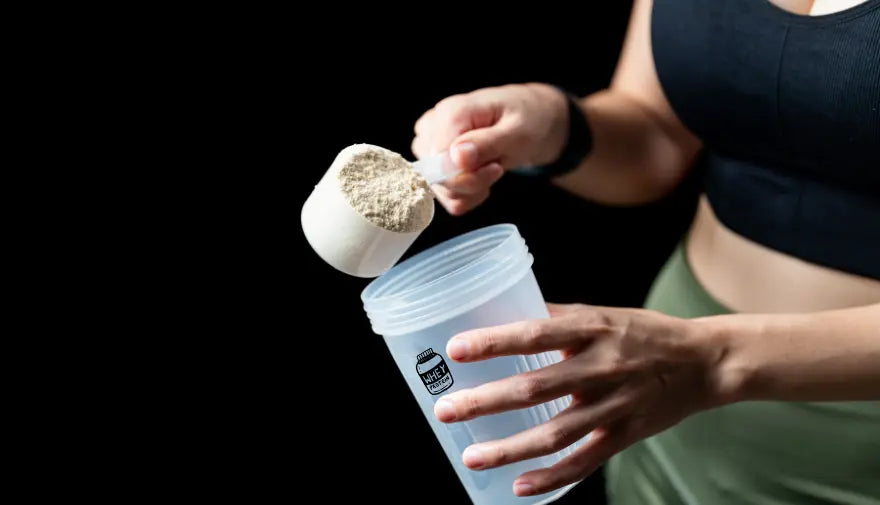
Beginner’s Guide To Whey Protein: Composition, Types, Benefits, And More
Whey protein is more than just protein. It has several other nutrients, like amino acids, that get absorbed quickly in the body.
Whether you are a fitness freak or just starting out your wellness journey, whey protein is a term that every health enthusiast comes across every once in a while.
So, if you are curious about what actually goes on behind the whey protein-making process, you are in the right place.
Let’s understand why it is essential for your health and recovery, and how it is made.
What Is Whey Protein?
To better understand the protein powder and its making process, we need to know a bit about milk and its major proteins. Milk contains mainly two types of proteins, namely, casein, which is 80% of the milk and whey, which is the remaining 20%.
When milk is curdled to make cheese, the remaining watery part contains whey, making it a byproduct in the process.
This liquid portion then goes through several processes before we get the final product in a powder form. Whey protein powder does not have a good flavour of its own, but can be enhanced by adding artificial/natural flavours like chocolate, strawberries, etc.
The final product we get is a mixture of proteins and sometimes added flavours. It is an essential supplement for gym enthusiasts, fitness-conscious individuals, and people who lack protein in their daily diet.
Several whey supplements are made with unhealthy additives that have side effects on the body. At Pumpd, each product goes through rigorous clinical testing under careful observation before it reaches you. So that you can rest assured while our whey protein works wonders on your body.
Composition Of Whey Protein
Whey protein is composed of various soluble proteins that are separated from the casein in milk. It majorly consists of beta-lactoglobulin, alpha-lactoglobulin, bovine serum albumin, and immunoglobulins. The other minor constituents include lactoferrin, glycomacropeptide, and lactoperoxidase enzymes.
What’s more, it contains the 9 essential amino acids and bioactive peptides that make whey a complete protein. It is an essential protein for tissue generation, muscle growth, and the repair of tissues.
What Are The Types Of Whey Protein?
Whey protein is available in different forms for different preferences and physical requirements. Majorly, they differ in the way they are processed.
1) Whey Protein Isolate: –
The Whey Protein Isolate (WPI) contains the highest amount of protein concentration, typically, more than 90%. The other remaining lactose, minerals, and fat amount to around 5%. This type of protein is best for people who want to maintain their muscle growth and control fat and carbohydrate intake.
2) Whey Protein Concentrate: –
Whey Protein Concentrate (WPC) is best for people who want to gain muscle mass and weight. This type contains around 70 -80% protein and a significant amount of fat and lactose. It is the most cost-effective whey powder and tastes better than the other types of whey protein.
3) Whey Protein Hydrolysate: –
Whey Protein Hydrolysate (WPH) contains the highest amount of protein, approximately 99%. It is made through a process called hydrolysis, where protein molecules are broken into smaller portions for better digestion by the body. Due to its high water solubility and better absorption, it is among the best supplement options for nutrition support.
What Are The Health Advantages Of Whey Protein?
Whey proteins are used for strength, muscle growth and tissue recovery. It is a popular choice among health enthusiasts, athletes, and bodybuilders.
Health Benefits of Whey Protein
1) Muscle Repair: –
After intense workouts, your muscles experience small tears that need to be repaired for growth and strength. Whey protein helps speed up this recovery process by providing essential amino acids. These amino acids help rebuild the damaged tissues and reduce muscle soreness. Regular intake supports faster healing and better performance in your next session.
2) Weight Loss: –
Whey protein can aid in weight loss by making you feel fuller. It decreases sudden hunger or the need to snack unnecessarily between meals. As your body uses more energy to digest protein, it also increases your calorie burn slightly. When used in conjunction with exercise and a balanced diet, it can aid in fat loss while maintaining muscle.
3) Decreased Blood Cholesterol: –
Some research indicates that whey protein has the ability to reduce LDL cholesterol, commonly referred to as "bad" cholesterol. Elevated levels of LDL have been associated with heart issues and arteriosclerosis, which is the clogging of arteries. Daily consumption of whey may improve lipid profiles and overall heart health. It is most effective when combined with a healthy, low-fat diet.
4) Better Heart Health: –
Whey protein not only reduces cholesterol but also contributes to healthy blood pressure. It has some bioactive peptides that enhance circulation and decrease the burden on the heart. Reduced inflammation levels also translate to fewer chances of cardiovascular diseases. Overall, it plays a modest but beneficial role towards maintaining your heart in great shape.
5) Reduced Inflammation: –
Chronic body inflammation can result in long-term conditions such as joint pain, tiredness, and heart disease. Whey protein has antioxidants such as cysteine that prevent inflammation. It also aids the immune system and accelerates the healing process. This makes it useful for everyday wellness as well as recovery following strenuous exercise.
6) Enhances Satiety: –
Protein is more satiating than carbs or fats, and whey protein is no different. It will keep you satisfied for longer and help regulate hunger and minimize the risk of overheating. This can be particularly useful if you're attempting to reduce calories or lose weight. It encourages better eating habits without leaving you feeling deprived.
How To Take Whey Protein
Whey protein consumption is based on your fitness goals and daily protein requirements. It can be consumed before or after workouts, or as a convenient meal supplement when you’re short on time. Mixing it with water or milk makes it easy to digest, and adding it to smoothies or oats is a great way to boost your nutrition. Just be sure not to use it as your sole source of protein—it's designed to supplement a balanced diet, not be used in place of whole foods.
Things to keep in mind
1) Post-Workout:
Take within 30 minutes of exercise for quicker recovery and muscle repair.
2) With Breakfast:
TMix with oats or smoothies for a protein-packed morning start.
3) As a Snack:
Mix with milk or fruit to suppress hunger and feel full between meals.
4) Using Water or Milk:
Mix one scoop with 200–250 ml of water or milk, depending on your preference.
5) Stick to Dosage:
1–2 scoops per day is enough for most people—don’t overdo it.
6) Stay Hydrated:
Drink plenty of water throughout the day to aid protein absorption.
6) Combine with Whole Foods:
Use alongside a balanced diet for the best long-term results
The Bottom Line
Whey protein is an exceptionally beneficial supplement for people who want to increase their muscle mass growth and those who lack protein intake in general.
It is safe, efficient, and easily digestible by the human body. Bodybuilders, athletes, players, and fitness-conscious people are particularly advised to take whey powder to maintain their protein intake
If you are searching for a brand that makes quality supplements backed by lab tests and authorized certifications, Pumpd is your one-stop solution for holistic wellness goals.







